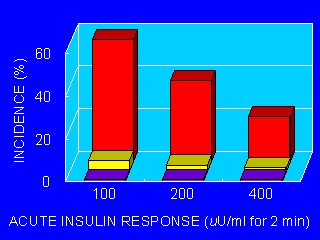Six-year Cumulative incidence of Type 2 DM
by Acute Insulin Response and Insulin Action

| |
Glucose Uptake <2.0 mg/kgMBS.min |
| |
Glucose Uptake 2.0 - 5.0 mg/kgMBS.min |
| |
Glucose Uptake >5.0 mg/kgMBS.min |
|
The most convincing evidence that insulin resistance precedes the
development of Type 2 diabetes comes from
hyperinsulinemic euglycemic clamp studies. Insulin
resistant Pima Indians i.e. those with low rates of
insulin-mediated glucose uptake (red bars), are at
highest risk of developing Type 2 diabetes over the
following 6-year period. The majority of individuals who
developed diabetes are in the lower third of the
distribution of glucose uptake (glucose uptake
<2.0mg/kg estimated metabolic body mass). The level of
insulin secretion also influences the risk of developing
Type 2 diabetes with those who have the greatest insulin
secretion in response to an intravenous glucose load
(>400uU/ml) having a lower incidence of diabetes than
those who have lower insulin secretory responses. The
high incidence in the more insulin resistant subjects
shown here suggests that a high degree of insulin
resistance in the Pima Indian population is necessary for
the development of Type 2 diabetes. The level of insulin
secretion modifies the rate of development of Type 2
diabetes among individuals who are insulin resistant.
|
